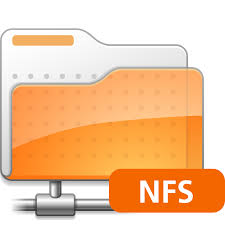Configuration de la machine serveur
Nous allons configurer notre service NFS (Network File System) pour avoir des répertoires accessibles via notre réseau sur notre serveur.
[pastacode lang= »bash » manual= »Passer%20en%20root%20%3A%20sudo%20su%0Ajoel%40sebastien%3A~%24%20sudo%20su%0A%5Bsudo%5D%20Mot%20de%20passe%20de%20joel%20%3A%20%0Aroot%40sebastien%3A%2Fhome%2Fjoel%23%0A » message= » » highlight= » » provider= »manual »/]
Ensuite, installer le paquet NFS
[pastacode lang= »bash » manual= »root%40sebastien%3A%2Fhome%2Fjoel%23%20apt%20install%20nfs-kernel-server%0ALecture%20des%20listes%20de%20paquets…%20Fait%0AConstruction%20de%20l’arbre%20des%20d%C3%A9pendances%0ALecture%20des%20informations%20d’%C3%A9tat…%20Fait%0AThe%20following%20additional%20packages%20will%20be%20installed%3A%0A%20%20keyutils%20libevent-2.0-5%20libnfsidmap2%20libtirpc1%20nfs-common%20rpcbind%20%0A… » message= » » highlight= » » provider= »manual »/]
Nous allons vérifier que le service est bien installé et lancé :
[pastacode lang= »bash » manual= »root%40sebastien%3A%2Fhome%2Fjoel%23%20systemctl%20status%20nfs-kernel-server%0A%E2%97%8F%20nfs-server.service%20-%20NFS%20server%20and%20services%0A%20%20%20Loaded%3A%20loaded%20(%2Flib%2Fsystemd%2Fsystem%2Fnfs-server.service%3B%20enabled%3B%20vendor%20preset%3A%20enabled)%0A%20%20%20Active%3A%20active%20(exited)%20since%20Thu%202019-03-14%2010%3A03%3A21%20CET%3B%203min%2032s%20ago%0A%20Main%20PID%3A%201753%20(code%3Dexited%2C%20status%3D0%2FSUCCESS)%0A%0Amars%2014%2010%3A03%3A21%20sebastien%20systemd%5B1%5D%3A%20Starting%20NFS%20server%20and%20services…%0Amars%2014%2010%3A03%3A21%20sebastien%20systemd%5B1%5D%3A%20Started%20NFS%20server%20and%20services.%0Aroot%40sebastien%3A%2Fhome%2Fjoel%23%0A » message= » » highlight= » » provider= »manual »/]
Pour vérifier que le serveur est lancé et accepter les connexions sur le port 2049 il faut lancer la commande : rpcinfo -p | grep nfs
[pastacode lang= »bash » manual= »root%40sebastien%3A%2Fhome%2Fjoel%23%20rpcinfo%20-p%20%7C%20grep%20nfs%0A%20%20%20%20100003%20%20%20%203%20%20%20tcp%20%20%202049%20%20nfs%0A%20%20%20%20100003%20%20%20%204%20%20%20tcp%20%20%202049%20%20nfs%0A%20%20%20%20100003%20%20%20%203%20%20%20udp%20%20%202049%20%20nfs%0A%20%20%20%20100003%20%20%20%204%20%20%20udp%20%20%202049%20%20nfs%0Aroot%40sebastien%3A%2Fhome%2Fjoel%23%0A » message= » » highlight= » » provider= »manual »/]
Nous allons maintenant créer un répertoire et un fichier dans se dernier. Le répertoire qui sera exporté via le réseau et accessible à tous les autres ordinateurs.
[pastacode lang= »bash » manual= »root%40sebastien%3A%2Fhome%2Fjoel%23%20mkdir%20%2Fvar%2Fnfs01%0Aroot%40sebastien%3A%2Fhome%2Fjoel%23%20echo%20toto%20%3E%20%2Fvar%2Fnfs01%2Ftoto%0Aroot%40sebastien%3A%2Fhome%2Fjoel%23%20cat%20%2Fvar%2Fnfs01%2Ftoto%0Atoto%0Aroot%40sebastien%3A%2Fhome%2Fjoel%23%0A » message= » » highlight= » » provider= »manual »/]
Ensuite nous allons configurer notre fichier d’exportation. C’est celui qui contient les configurations des répertoires à exporter.
[pastacode lang= »bash » manual= »root%40sebastien%3A%2Fhome%2Fjoel%23%20vi%20%2Fetc%2Fexports » message= » » highlight= » » provider= »manual »/]
Ensuite, rajouter une ligne par répertoire que vous souhaitez exporter via le réseau comme ceux-ci.
[pastacode lang= »bash » manual= »%23%20%2Fetc%2Fexports%3A%20the%20access%20control%20list%20for%20filesystems%20which%20may%20be%20exported%0A%23%20%20%20%20%20%20%20%20%20%20%20%20%20%20%20to%20NFS%20clients.%20%20See%20exports(5).%0A%23%0A%23%20Example%20for%20NFSv2%20and%20NFSv3%3A%0A%23%20%2Fsrv%2Fhomes%20%20%20%20%20%20%20hostname1(rw%2Csync%2Cno_subtree_check)%20hostname2(ro%2Csync%2Cno_subtree_check)%0A%23%0A%23%20Example%20for%20NFSv4%3A%0A%23%20%2Fsrv%2Fnfs4%20%20%20%20%20%20%20%20gss%2Fkrb5i(rw%2Csync%2Cfsid%3D0%2Ccrossmnt%2Cno_subtree_check)%0A%23%20%2Fsrv%2Fnfs4%2Fhomes%20%20gss%2Fkrb5i(rw%2Csync%2Cno_subtree_check)%0A%23%0A%2Fvar%2Fnfs01%20*(rw%2Csync%2Cno_subtree_check%2Cno_root_squash)%0A » message= » » highlight= » » provider= »manual »/]
La ligne sera rédigée en fonction de la version de votre client NFS. Celle que nous avons utilisée sera compatible dès la version 2. Pour recharger le fichier de configuration d’NFS il faut utiliser la commande : exportfs -a
[pastacode lang= »bash » manual= »root%40sebastien%3A%2Fhome%2Fjoel%23%20exportfs%20-a%0Aroot%40sebastien%3A%2Fhome%2Fjoel%23%0A » message= » » highlight= » » provider= »manual »/]
Pour activer le lancement du serveur NFS au démarrage, vous devez l’enregistrer dans le service présent au démarrage.
[pastacode lang= »bash » manual= »root%40sebastien%3A%2Fhome%2Fjoel%23%20systemctl%20enable%20nfs-kernel-server%0ASynchronizing%20state%20of%20nfs-kernel-server.service%20with%20SysV%20service%20script%20with%20%2Flib%2Fsystemd%2Fsystemd-sysv-install.%0AExecuting%3A%20%2Flib%2Fsystemd%2Fsystemd-sysv-install%20enable%20nfs-kernel-server%0Aroot%40sebastien%3A%2Fhome%2Fjoel%23%0A » message= » » highlight= » » provider= »manual »/]
Configuration du client
Pour configurer le client NFS, nous allons commencer par nous connecter la machine cliente et installer le client NFS client.
[pastacode lang= »bash » manual= »joel%40claude%3A~%24%20sudo%20su%0A%5Bsudo%5D%20Mot%20de%20passe%20de%20joel%20%3A%20%0Aroot%40claude%3A%2Fhome%2Fjoel%23%0A » message= » » highlight= » » provider= »manual »/]
Ensuite on install le paquet nfs client.
[pastacode lang= »bash » manual= »root%40claude%3A%2Fhome%2Fjoel%23%20apt%20install%20nfs-common%0ALecture%20des%20listes%20de%20paquets…%20Fait%0AConstruction%20de%20l’arbre%20des%20d%C3%A9pendances%0ALecture%20des%20informations%20d’%C3%A9tat…%20Fait%0ALes%20paquets%20suivants%20ont%20%C3%A9t%C3%A9%20install%C3%A9s%20automatiquement%20et%20ne%20sont%20plus%20n%C3%A9cessaires%20%3A%0A%20%20libirs-export141%20libisccc-export140%20libisccfg-export140%20policycoreutils%20selinux-utils%0A » message= » » highlight= » » provider= »manual »/]
Une fois le paquet installé nous allons créer le répertoire de montage distant pour notre répertoire exporté.
[pastacode lang= »bash » manual= »root%40claude%3A%2Fhome%2Fjoel%23%20mkdir%20%2Fmnt%2Fnfs01%0Aroot%40claude%3A%2Fhome%2Fjoel%23%0A » message= » » highlight= » » provider= »manual »/]
Ensuite nous allons monter le répertoire distant. Notre machine hébergeant le serveur NFS est disponible via l’ip 192.168.57.4.
[pastacode lang= »bash » manual= »root%40claude%3A%2Fhome%2Fjoel%23%20mount%20-t%20nfs%20192.168.57.4%3A%2Fvar%2Fnfs01%20%2Fmnt%2Fnfs01%0Aroot%40claude%3A%2Fhome%2Fjoel%23%20ls%20%2Fmnt%2Fnfs01%2F%0Atoto%0Aroot%40claude%3A%2Fhome%2Fjoel%23%0A » message= » » highlight= » » provider= »manual »/]
Pour finir dans le fichier de configuration de la fstab ajouter la ligne suivante pour le montage automatique de notre nfs au démarrage.
[pastacode lang= »bash » manual= »192.168.57.4%3A%2Fvar%2Fnfs01%20%20%20%20%20%20%20%2Fmnt%2Fnfs01%20%20%20%20%20%20nfs » message= » » highlight= » » provider= »manual »/]

Laisser un commentaire